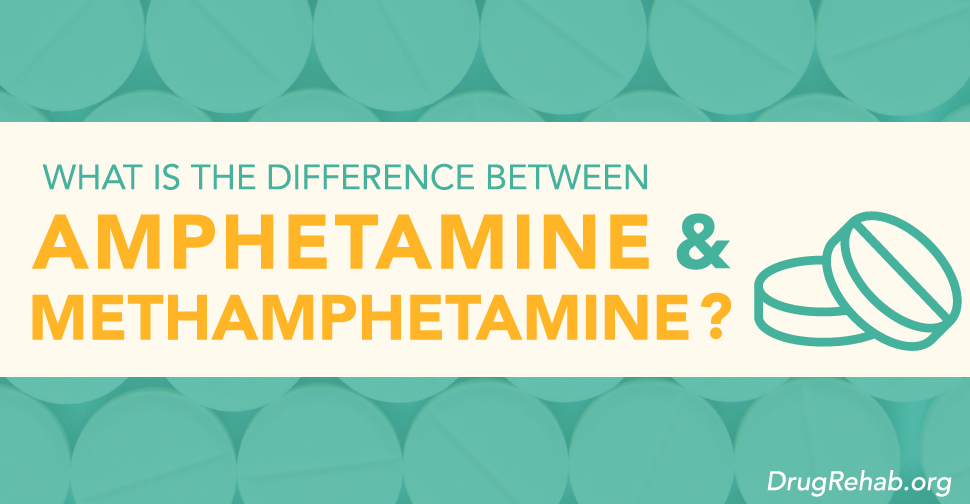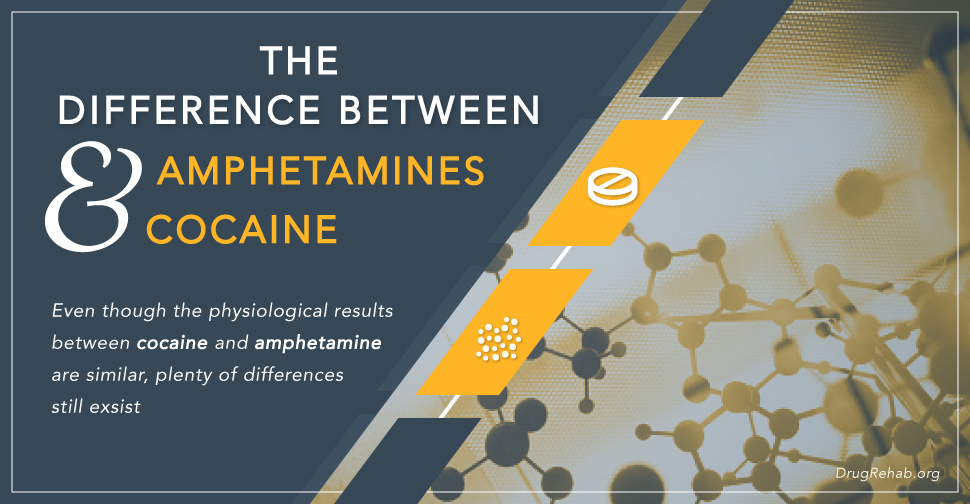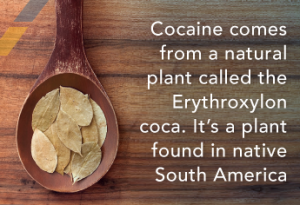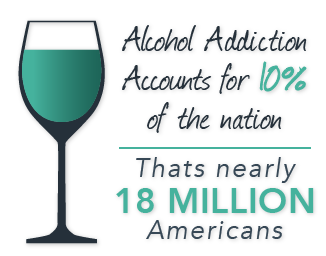
With so many drugs of abuse available today, it’s easy to get them confused. Amphetamines are a group of central nervous system (CNS) stimulant drugs with psychoactive properties, meaning they affect the mind. The group of amphetamines is comprised by any drugs classified as amphetamine, dextroamphetamine, and methamphetamine, according to the Center for Substance Abuse Research (CESAR).
With that stated, methamphetamine is often abused in an illicit form, known as crystal meth. The names of these two drugs are very similar, but abuse of them is quite different and results in differing consequences.
Amphetamine: Definition, Use, And Abuse
As previously mentioned, amphetamine is a stimulant which means it has a stimulating effect on your body. When you take amphetamine, it helps improve your mood and increases alertness. Historically, amphetamines were not prescribed for stimulant effects, but today they help people with a number of medical conditions.
People may take amphetamine for obesity, narcolepsy, and attention deficit/hyperactivity disorder (ADHD). Common brands of amphetamine include Adderall, Desoxyn, Dexedrine, and DextroStat.

Amphetamine is prescribed in pill form, and intended for oral use with a fairly slow release. People who abuse it may crush and snort the powder, combine it with water into a solution and inject it, or smoke it by inhaling vapors.
Abuse of amphetamine can cause a number of side effects, as abuse enhances side effects of the drugs:
- Increased body temperature
- Hostility
- Paranoia
- Increased blood pressure and/or heart rate
- Alertness, talkativeness
- Euphoria
- Dry mouth
- Lack of appetite
- Pupil dilation
- Heavy breathing
- Headache or nausea
- Heart palpitations
- Tremors
- Muscle spasms
- Change in sexual behavior
With prolonged abuse, the severity of these effects worsens and can result in psychosis, psychological issues, behavioral changes, convulsions, coma, or even death.
Methamphetamine: Definition, Use, And Abuse
Methamphetamine is a stimulant within the amphetamine class used to treat obesity and ADHD. While it can be a helpful medication for these conditions when taken as directed, methamphetamine has become a popular drug of abuse. This is especially true of the illicit form, crystal meth.
 As with amphetamine, methamphetamine is available under prescription in pill form. When people abuse it, they also crush and snort it, or mix it with water to make a solution to inject. But methamphetamine (commonly called meth) may also be formed into a solid, crystal-like form and smoked.
As with amphetamine, methamphetamine is available under prescription in pill form. When people abuse it, they also crush and snort it, or mix it with water to make a solution to inject. But methamphetamine (commonly called meth) may also be formed into a solid, crystal-like form and smoked.
Meth poses great health and behavioral risks for those who abuse it, similar to amphetamines. Why? The U.S. National Library of Medicine explains, “meth at first causes a rush of good feelings, but then users feel edgy, overly excited, angry or afraid.” The drug is also highly addictive, which means you can develop addiction after abusing it for only a short time.
Some of the most severe problems associated with abuse of methamphetamine include:
- Increasing body temperature until you faint
- Severe itching, which can lead to scratching to the point of lesions and, later, infections
- A condition known as meth mouth, terrible dental and mouth problems including cracked teeth
- Changes to thought processes
- Changes to behavior and mood
The Dangers Of Abusing Crystal Meth
If the risk of side effects weren’t alarming enough, abusing the illicit crystal meth can have some consequences that would be hard to undo. One of the greatest of these is the greatly increased risk of overdose when abusing crystal meth.
Meth is a highly addictive drug, but when you smoke a substance instead of taking it a different way (orally, for example) that substance produces quicker results. It’s this rush feeling, the quick feeling of euphoria and other side effects, that really drive development of addiction.
Meth is so potent, the risk of overdose is high even after just a few times taking it. And overdose doesn’t always mean people can simply be treated at a hospital and return to daily life. Overdose of meth can cause heart attack, stroke, or permanent damage to organs—all conditions which can ultimately be fatal.
Addiction to meth is so powerful, it affects not just your health but your life. When you’re living for addiction, your priorities are aligned with seeking use of the drug, and little else. Before meth takes over your life, or worse, we can help you find a treatment plan that will address all your needs. DrugRehab.org can connect you with private, inpatient rehab centers headed by staff with experience who offer caring support.
The Dangers Of Abusing Prescription Drugs
So what do amphetamine and methamphetamine have in common? They are both prescription drugs, or at least they started out that way. This means you have to have a prescription to get the licit forms of the drugs, and abuse should be easily avoided.
Unfortunately, we tend to trust our prescriptions to be safe and free from risk of addiction. But many medications are habit-forming, can foster abuse, and later lead to addiction. This isn’t to say all prescription drugs are bad, but that you have to be very careful when dealing with highly addictive medication.

Thousands of people in the nation are addicted to prescription drugs every year, but only a small portion of these people receive care for this issue. Perhaps it seems that abusing prescription drugs isn’t all bad because the prescription will eventually end, but this is rarely the end. Once you become addicted, addiction doesn’t go away because your prescription has ended.
If you can’t refill your script, and begin experiencing uncomfortable withdrawal symptoms like headache, nausea, or vomiting, you may reach a desperate point. In that time, you likely will not be opposed to trying an alternate drug, even an illicit one. This is how subsequent drug abuse and addiction begins.
Abusing prescription drugs isn’t dangerous just for the length of the prescription, but for the health consequences and repercussions that can follow.
Solutions In Treatment
So what can be done to help those who’ve fallen victim to amphetamine or methamphetamine abuse? Treatment. In fact, treatment is the best solution we have to help people overcome substance abuse and addiction, and it’s proven effective in the lives of thousands every year.
At our rehab centers, you’ll be taken away from the messy environment of addiction and will heal in a welcoming, substance-free environment. In treatment you’ll be surrounded by experts in the field, trained and licensed clinical and medical staff, and peers who are traveling the same healing journey.
Our facilities also provide some of the best evidence-based treatment modalities available. We recognize that each person requires different aspects of treatment. Our programs are as unique as our patients—each treatment plan will be tailored to your individual needs. Some of the methods we integrate into treatment plans include:
- Cognitive Behavioral Therapy (CBT)
- Dialectical Behavioral Therapy (DBT)
- Counseling: group, family, and individual
- Gender-specific treatment
- Alternative therapy: Adventure and Wilderness therapy
- Dual diagnosis treatment
- Mental health services and treatment
- Aftercare support
Find Your Treatment Solution Today
Methamphetamine and amphetamine drugs are not drugs you want to experience, but if you are struggling with abuse of them, we can help. It’s not easy to reach out for help, but we’re here to make the process of getting the healing you need as smooth as possible.
Contact us today at DrugRehab.org to learn more about substance abuse, treatment options, and to speak to one of our specialists about getting into a treatment program.
For More Information Related to “What Is The Difference Between Amphetamine And Methamphetamine?” Be Sure To Check Out These Additional Resources From DrugRehab.org:
- How Long Does Methamphetamine Stay In Your System
- Understanding The Combat Methamphetamine Act
- Sepsis From Intravenous (IV) Drug Use
- Amphetamine Abuse on College Campuses
Sources
National Institute On Drug Abuse—DrugFacts: Methamphetamine
U.S. National Library Of Medicine—Substance Use: Amphetamines





 Cocaine and amphetamines have very similar
Cocaine and amphetamines have very similar 





 Alcohol
Alcohol


